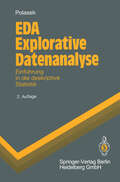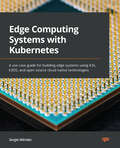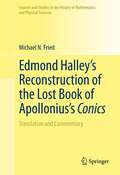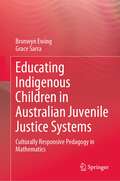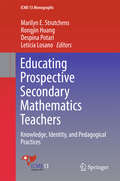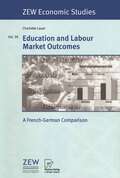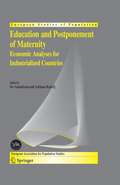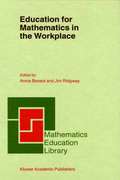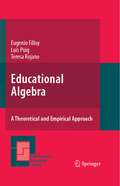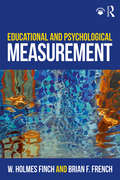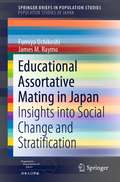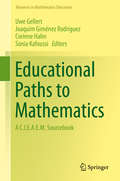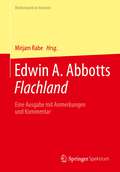- Table View
- List View
EDA Explorative Datenanalyse: Einführung in die deskriptive Statistik (Springer-Lehrbuch)
by Wolfgang PolasekExplorative Datenanalyse (EDA), deskriptive Statistik und graphische Darstellungstechnik werden unter einem gemeinsamen Aspekt beschrieben. Dem Studenten im ersten Studienjahr soll damit bereits möglichst früh ein Überblick über die verschiedenen Typen der statistischen Modellierung geboten werden. Das Buch präsentiert resistente statistische Methoden, aber ohne deren wahrscheinlichkeitstheoretische oder induktive Begründung. An mehreren Beispielen aus den Sozial- und Wirtschaftswissenschaften wird gezeigt, wie ein deskriptiver Modellbildungsprozeß mit einfachen Mitteln möglich ist.
Edge Computing Systems with Kubernetes: A Use Case Guide For Building Edge Systems Using K3s, K3os, And Open Source Cloud Native Technologies
by Sergio MéndezA use case guide for building edge systems using K3s, k3OS, and open source cloud native technologies
Edmond Halley’s Reconstruction of the Lost Book of Apollonius’s Conics: Translation and Commentary (Sources and Studies in the History of Mathematics and Physical Sciences)
by Michael N. FriedApollonius’s Conics was one of the greatest works of advanced mathematics in antiquity. The work comprised eight books, of which four have come down to us in their original Greek and three in Arabic. By the time the Arabic translations were produced, the eighth book had already been lost. In 1710, Edmond Halley, then Savilian Professor of Geometry at Oxford, produced an edition of the Greek text of the Conics of Books I-IV, a translation into Latin from the Arabic versions of Books V-VII, and a reconstruction of Book VIII. The present work provides the first complete English translation of Halley’s reconstruction of Book VIII with supplementary notes on the text. It also contains 1) an introduction discussing aspects of Apollonius’s Conics 2) an investigation of Edmond Halley's understanding of the nature of his venture into ancient mathematics, and 3) an appendices giving a brief account of Apollonius’s approach to conic sections and his mathematical techniques.This book will be of interest to students and researchers interested in the history of ancient Greek mathematics and mathematics in the early modern period.
Educating Indigenous Children in Australian Juvenile Justice Systems: Culturally Responsive Pedagogy in Mathematics
by Bronwyn Ewing Grace SarraThis book addresses key issues in the context of the national policy of educating children accused of crimes in Juvenile Courts in Australia. For several decades, National and State Governments in Australia have struggled to define education, constantly seeking to improve the way society applies the concept. This book presents an accurate portrayal of consequences of the education policy of trying to educate troubled children and young people in trouble with the law. It describes the work of juvenile detention centre mathematics teachers and their teaching contexts. It portrays teachers as learners, who ventured with researchers with a theoretical perspective. This book focuses on culturally responsive pedagogies that seek to understand the ways Indigenous children and young people in juvenile detention make sense of their mathematical learning, which, until the time of detention, has been plagued by failure. It examines how the underperformance of Aboriginal and Torres Strait Islander students, and students from low socioeconomic backgrounds are strong determinants of their overrepresentation in the juvenile justice system in Australia. This book presents the argument that if the students’ literacy and numeracy levels can be improved, there is opportunity to build better futures away from involvement in the juvenile justice system and towards productive employment to improve life chances.
Educating Prospective Secondary Mathematics Teachers: Knowledge, Identity, and Pedagogical Practices (ICME-13 Monographs)
by Marilyn E. Strutchens Rongjin Huang Despina Potari Leticia LosanoThis book highlights innovative approaches to preparing secondary mathematics teachers. Based on empirical findings gathered in several countries on five continents, it provides a wealth of best practices for preparing secondary mathematics teachers, and discusses issues related to their professional and personal growth, such as identity, content knowledge, and pedagogical content knowledge which also includes knowledge of integrating technology into teaching and learning mathematics. Divided into four parts, the book focuses on field experiences, technologies, tools and resources, teacher knowledge, and teacher professional identities. Some of the main threads running through the book are: the importance of university and school partners working together to ensure preservice secondary mathematics teacher’ success in developing pedagogical strategies that lead toward students’ mathematical engagement and achievement; the critical need for preservice secondary mathematics teachers to develop strong content knowledge and pedagogical content knowledge; and the importance of providing opportunities, during pre-service education, for developing prospective teachers ´professional identities.
Education and Labour Market Outcomes: A French-German Comparison (ZEW Economic Studies #30)
by Charlotte LauerEducation and Postponement of Maternity: Economic Analyses for Industrialized Countries (European Studies of Population #15)
by Siv Gustafsson Adriaan KalwijThis book examines economic aspects of the role of women’s education in the postponement of maternity in ten industrialized countries or regions: Sweden, Norway, Italy, Spain, Ireland, the Netherlands and Western Germany, the Czech Republic and Eastern Germany, and the United States. Each is investigated using survey data relating age at motherhood with the investment in education of the mother. The result is a detailed picture of the economics of fertility decisions.
Education for Mathematics in the Workplace (Mathematics Education Library #24)
by Annie Bessot Jim RidgwayThis timely volume raises issues concerning the nature of school mathematics and mathematics at work, and the challenges of teaching valuable mathematics in school and providing appropriate training for a variety of careers. It offers lively commentaries on important `hot' topics: transferring knowledge and skill across contexts; ‘authentic mathematics’; comparability of different types of assessment; and analyses of research methods.
Educational Algebra: A Theoretical and Empirical Approach (Mathematics Education Library #43)
by Eugenio Filloy Teresa Rojano Luis PuigThis book takes a theoretical perspective on the study of school algebra, in which both semiotics and history occur. The Methodological design allows for the interpretation of specific phenomena and the inclusion of evidence not addressed in more general treatments. The book gives priority to "meaning in use" over "formal meaning". These approaches and others of similar nature lead to a focus on competence rather than a user’s activity with mathematical language.
Educational and Psychological Measurement
by W. Holmes Finch Brian F. FrenchThis new text provides the most current coverage of measurement and psychometrics in a single volume. Authors W. Holmes Finch and Brian F. French first review the basics of psychometrics and measurement, before moving on to more complex topics such as equating and scaling, item response theory, standard setting, and computer adaptive testing. Also included are discussions of cutting-edge topics utilized by practitioners in the field, such as automated test development, game-based assessment, and automated test scoring. This book is ideal for use as a primary text for graduate-level psychometrics/measurement courses, as well as for researchers in need of a broad resource for understanding test theory. Features: "How it Works" and "Psychometrics in the Real World" boxes break down important concepts through worked examples, and show how theory can be applied to practice. End-of-chapter exercises allow students to test their comprehension of the material, while suggested readings and website links provide resources for further investigation. A collection of free online resources include the full output from R, SPSS, and Excel for each of the analyses conducted in the book, as well as additional exercises, sample homework assignments, answer keys, and PowerPoint lecture slides.
Educational and Psychological Measurement
by W. Holmes Finch Brian F. FrenchThis new text provides the most current coverage of measurement and psychometrics in a single volume. Authors W. Holmes Finch and Brian F. French first review the basics of psychometrics and measurement, before moving on to more complex topics such as equating and scaling, item response theory, standard setting, and computer adaptive testing. Also included are discussions of cutting-edge topics utilized by practitioners in the field, such as automated test development, game-based assessment, and automated test scoring. This book is ideal for use as a primary text for graduate-level psychometrics/measurement courses, as well as for researchers in need of a broad resource for understanding test theory. Features: "How it Works" and "Psychometrics in the Real World" boxes break down important concepts through worked examples, and show how theory can be applied to practice. End-of-chapter exercises allow students to test their comprehension of the material, while suggested readings and website links provide resources for further investigation. A collection of free online resources include the full output from R, SPSS, and Excel for each of the analyses conducted in the book, as well as additional exercises, sample homework assignments, answer keys, and PowerPoint lecture slides.
Educational Assortative Mating in Japan: Insights into Social Change and Stratification (SpringerBriefs in Population Studies)
by Fumiya Uchikoshi James M. RaymoThis book represents a first attempt to comprehensively discuss and investigate causes and potential implications of changing patterns of spouse pairing in Japan and to consider similarities and differences with patterns observed in the USA and other low-fertility Western societies. In this book, research on educational assortative mating in Japan is summarized and updated. This book contributes to research on the demography of contemporary Japan by overviewing theoretical and empirical linkages between marriage behavior and processes of social and economic stratification. It also extends the large body of research on assortative mating and stratification by incorporating insights from the understudied context of Japan. The authors draw upon multiple data sources – both survey and administrative data – to update and extend previous research on “who marries whom” in Japan. The wide range of consequences considered includes income inequality, the intergenerational transmission of advantage and disadvantage, marriage and fertility timing, lifelong singlehood, childlessness, and the family roles of husbands and wives. Throughout the manuscript, Japan is considered in comparative perspective by employing the large USA and international literatures on assortative mating.
Educational Data Analytics for Teachers and School Leaders (Advances in Analytics for Learning and Teaching)
by Sofia Mougiakou Dimitra Vinatsella Demetrios Sampson Zacharoula Papamitsiou Michail Giannakos Dirk IfenthalerEducational Data Analytics (EDA) have been attributed with significant benefits for enhancing on-demand personalized educational support of individual learners as well as reflective course (re)design for achieving more authentic teaching, learning and assessment experiences integrated into real work-oriented tasks.This open access textbook is a tutorial for developing, practicing and self-assessing core competences on educational data analytics for digital teaching and learning. It combines theoretical knowledge on core issues related to collecting, analyzing, interpreting and using educational data, including ethics and privacy concerns. The textbook provides questions and teaching materials/ learning activities as quiz tests of multiple types of questions, added after each section, related to the topic studied or the video(s) referenced. These activities reproduce real-life contexts by using a suitable use case scenario (storytelling), encouraging learners to link theory with practice; self-assessed assignments enabling learners to apply their attained knowledge and acquired competences on EDL. By studying this book, you will know where to locate useful educational data in different sources and understand their limitations; know the basics for managing educational data to make them useful; understand relevant methods; and be able to use relevant tools; know the basics for organising, analysing, interpreting and presenting learner-generated data within their learning context, understand relevant learning analytics methods and be able to use relevant learning analytics tools; know the basics for analysing and interpreting educational data to facilitate educational decision making, including course and curricula design, understand relevant teaching analytics methods and be able to use relevant teaching analytics tools; understand issues related with educational data ethics and privacy.This book is intended for school leaders and teachers engaged in blended (using the flipped classroom model) and online (during COVID-19 crisis and beyond) teaching and learning; e-learning professionals (such as, instructional designers and e-tutors) of online and blended courses; instructional technologists; researchers as well as undergraduate and postgraduate university students studying education, educational technology and relevant fields.
Educational Encounters: Nordic Studies in Early Childhood Didactics (International Perspectives on Early Childhood Education and Development #4)
by Niklas Pramling and Ingrid Pramling SamuelssonQualitative analyses of young children’s learning in natural settings are rare, so this new book will make educators sit up and pay attention. It lays out a Nordic, or continental European teaching and learning paradigm whose didactic framework is distinct from the Anglo-American system. This analysis, which features contributions and case studies from researchers in a range of subjects, is built on principles such as the learner’s perspective, establishing sufficient intersubjectivity, ‘pointing out’, and informing experience linguistically. After clarifying some historical background, the book discusses the contemporary emphasis in early childhood education on pedagogy/learning. What should ‘didactics’ mean in educating young children?The book examines the opportunities for learning that teachers provide for children in early childhood education, as well as how children respond to these opportunities. It presents empirical studies from a variety of naturalistic settings, including mathematics, making visual art, ecology, music, dance, literacy and story-telling, as well as learning about gender, morality and democracy. The authors seek to answer key questions about the processes involved in both teaching and learning. What challenges do teachers face as they try to expand children’s knowledge in various fields of learning? How do they respond to these challenges, and what can we learn about children’s corresponding uptake? What now requires further research? One key distinction in researching children’s learning is between studies that look at ‘process’ and those that analyze ‘product’. In the tradition of Piaget, Vygotsky and Werner, as well as Mercer and Valsiner’s more recent work, this book advocates the importance and relative rareness of the former type of study.
Educational Interfaces between Mathematics and Industry: Report on an ICMI-ICIAM-Study (New ICMI Study Series #16)
by Alain Damlamian, José Francisco Rodrigues and Rudolf SträßerThis book is the “Study Book” of ICMI-Study no. 20, which was run in cooperation with the International Congress on Industry and Applied Mathematics (ICIAM). The editors were the co-chairs of the study (Damlamian, Straesser) and the organiser of the Study Conference (Rodrigues). The text contains a comprehensive report on the findings of the Study Conference, original plenary presentations of the Study Conference, reports on the Working Groups and selected papers from all over world. This content was selected by the editors as especially pertinent to the study each individual chapter represents a significant contribution to current research.
Educational Measurement for Applied Researchers: Theory into Practice
by Margaret Wu Hak Ping Tam Tsung-Hau JenThis book is a valuable read for a diverse group of researchers and practitioners who analyze assessment data and construct test instruments. It focuses on the use of classical test theory (CTT) and item response theory (IRT), which are often required in the fields of psychology (e.g. for measuring psychological traits), health (e.g. for measuring the severity of disorders), and education (e.g. for measuring student performance), and makes these analytical tools accessible to a broader audience. Having taught assessment subjects to students from diverse backgrounds for a number of years, the three authors have a wealth of experience in presenting educational measurement topics, in-depth concepts and applications in an accessible format. As such, the book addresses the needs of readers who use CTT and IRT in their work but do not necessarily have an extensive mathematical background. The book also sheds light on common misconceptions in applying measurement models, and presents an integrated approach to different measurement methods, such as contrasting CTT with IRT and multidimensional IRT models with unidimensional IRT models. Wherever possible, comparisons between models are explicitly made. In addition, the book discusses concepts for test equating and differential item functioning, as well as Bayesian IRT models and plausible values using simple examples. This book can serve as a textbook for introductory courses on educational measurement, as supplementary reading for advanced courses, or as a valuable reference guide for researchers interested in analyzing student assessment data.
Educational Paths to Mathematics: A C.I.E.A.E.M. Sourcebook (Advances in Mathematics Education)
by Uwe Gellert Joaquim Giménez Rodríguez Corinne Hahn Sonia KafoussiThis book offers fresh insight and understanding of the many ways in which children, youth and adults may find their paths to mathematics. The chapters of the volume offer and analyse promising new ways into mathematics. The focus is on spaces and modalities of learning, dialogue and inquiry, embodiment and aesthetic experience, information and communication technology and on the use of mathematics in public communication. The chapters present new mathematical activities and conceptions enriching the repertoire of mathematics education practices. Critical commentaries discuss the innovative potential of the new approaches to the teaching and learning of mathematics. As a consequence, the commentaries point to requirements and open issues in the field of research in mathematics education.The volume is remarkably international. Teachers and researchers from 14 countries authored 21 chapters and 7 commentaries. The reader is invited to reflect on the particular effect of presenting avenues to mathematics contrived in diverse national settings in which the praxis of mathematics education might look different compared to what happens in the reader’s place.The book starts a series of sourcebooks edited by CIEAEM, the Commission Internationale pour l’Etude et l’Amélioration de l’Enseignement des Mathématiques / International Commission for the Study and Improvement of Mathematics Education.
Educators' Learning from Lesson Study: Mathematics for Ages 5-13 (WALS-Routledge Lesson Study Series)
by Akihiko Takahashi Thomas McDougal Shelley Friedkin Tad WatanabeOffering voices from the field – the first of its kind outside of Japan – this guide to teaching and learning elementary mathematics highlights real case examples from teachers and educators who share what they have learned through Lesson Study. The teachers’ reports provide vivid examples of new insights and ideas about mathematics, about pedagogy and lesson design, about student learning, and about professional collaboration gained through Lesson Study. Each report includes an abbreviated plan of the specific research lesson that led to the new insights, which readers can draw from to replicate the powerful learning in their own community. The case examples of this book are from Lesson Study in mathematics, elementary to lower secondary grade levels, focused on what teachers and educators have learned about improving mathematics teaching and learning; but many ideas from each report can be applied to other subjects and different grade levels. This unique book will be an excellent resource for mathematics teachers in training and practice who seek to improve mathematics teaching and learning in their own and others’ classrooms, including researchers and school administrators who lead professional development.
Educators' Learning from Lesson Study: Mathematics for Ages 5-13 (WALS-Routledge Lesson Study Series)
by Tad Watanabe Akihiko Takahashi Thomas McDougal Shelley FriedkinOffering voices from the field – the first of its kind outside of Japan – this guide to teaching and learning elementary mathematics highlights real case examples from teachers and educators who share what they have learned through Lesson Study. The teachers’ reports provide vivid examples of new insights and ideas about mathematics, about pedagogy and lesson design, about student learning, and about professional collaboration gained through Lesson Study. Each report includes an abbreviated plan of the specific research lesson that led to the new insights, which readers can draw from to replicate the powerful learning in their own community. The case examples of this book are from Lesson Study in mathematics, elementary to lower secondary grade levels, focused on what teachers and educators have learned about improving mathematics teaching and learning; but many ideas from each report can be applied to other subjects and different grade levels. This unique book will be an excellent resource for mathematics teachers in training and practice who seek to improve mathematics teaching and learning in their own and others’ classrooms, including researchers and school administrators who lead professional development.
EDV-Einsatz in Krankenanstalten (Schriftenreihe der Wissenschaftlichen Landesakademie für Niederösterreich)
by Eike E. Dittel Peter KopacekDer Einsatz elektronischer Datenverarbeitung in Krankenanstalten erfährt in den letzten Jahren eine stürmische Entwicklung. War ursprünglich nur daran gedacht, mit Hilfe der Datenverarbeitung administrative Tätigkeiten zu vereinfachen, so wird nun bereits ein integriertes Krankenhausinformationssystem angestrebt. Daten sollen möglichst am Ort ihrer Entstehung erfaßt werden und die Weiterleitung dieser Daten an alle Stationen, Abteilungen und Leistungsstellen, die diese Daten benötigen, sowie eine patientengerechte Auswertung dieser Daten sollen garantiert werden. Die Wissenschaftliche Landesakademie für Niederösterreich beschäftigt sich in Zusammenarbeit mit dem Zentrum für medizinische Aus-, Fort- und Weiterbildung mit dieser Thematik. Die Beiträge dieses Buches beleuchten die wissenschaftlichen Aspekte eines solchen Krankenhausinformationssystems, informieren über die angebotenen Systeme, geben Beispiele, wie Daten zu verwalten sind, und berichten über Anforderungskriterien von Anwenderseite.
EDV-Management: Eine empirische Untersuchung der Entwicklung von Anwendungssystemen in deutschen Unternehmen (Betriebs- und Wirtschaftsinformatik #16)
by Jürgen Selig1. 1 Problemstellung und Ziele der Untersuchung 1 1. 2 Methodische Einordnung der Untersuchung 4 1. 3 Erarbeitung eines konzeptionellen Bezuqsrahmens 6 1. 4 Verlauf der Untersuchung 10 1. 5 Aufbau der Arbeit 11 2. Auswahl der Erhebungsmethoden, Unternehmen und Interviewpartner 12 2. 1 Auswahl und Einsatz der Erhebungsmethoden 12 2. 1. 1 Befragung durch mUndliches Interview 12 2. 1. 2 Dokumentenanalyse 15 2. 1. 3 Einzelfallstudien 18 2. 2 Auswahl der Unternehmen und der Interviewpartner 19 2. 2. 1 Auswahl der Unternehmen 19 2. 2. 2 Auswahl der Interviewpartner 20 2. 3 Statistische Auswertung 22 3. Merkmale der Unternehmen und der Interviewpartner 25 3. 1 Beschreibung der Unternehmen 25 3. 2 Beschreibung der Interviewpartner 28 3. 3 Beschreibung der Effizienzmerkmale 33 4. Management der EDV-Abteilung 39 4. 1 Ziele, Selbstverstandnis, Beurteilungskriterien und Probleme 41 der EDV-Abteilung 4. 1. 1 Verbreitung von EDV-Abteilungszielen und Aufgaben- 42 beschreibungen 4. 1. 2 Selbstverstandnis der EDV-Abteilung 43 4. 1. 3 Beurteilungskriterien und Image der EDV-Abteilung 45 4. 1. 4 Hauptprobleme der EDV-Abteilung 51 4. 1. 5 Problembereiche bei der Entwicklung von Anwendungssystemen 52 4. 2 Groae der EDV-Abteilung 58 4. 3 Eingliederung der EDV-Abteilung in das Unternehmen 63 63 4. 3. 1 Eingliederung der EDV-Abteilung in der Literatur 4. 3. 2 Eingliederung der EDV-Abteilung in der Untersuchung 67 x 4. 3. 3 Zentralisierung versus Dezentralisierung der EDV-Funktion 76 in der Literatur 4. 3. 4 Zentralisierung versus Dezentralisierung der EDV-Funktion 78 in der Untersuchung 4.
EDV-Systeme im Finanz- und Rechnungswesen: Anwendergespräch Osnabrück, 8. – 9. Juni 1982 (Betriebs- und Wirtschaftsinformatik #1)
by P. StahlknechtEdwin A. Abbotts Flachland: Eine Ausgabe mit Anmerkungen und Kommentar (Mathematik im Kontext)
Edwin A. Abbotts Flachland erzählt auf humorvolle Weise die Geschichte einer zweidimensionalen Welt aus der Sicht eines Quadrats, das in die Mysterien des dreidimensionalen Raums eingeweiht wird. Die vorliegende Neuübersetzung des Romans von 1884 wird durch einen durchgängigen Kommentar ergänzt, der auf der 2010 bei Cambridge University Press erschienenen Ausgabe von William Lindgren und Thomas Banchoff basiert. Damit liegt zum ersten Mal in deutscher Sprache eine ausführlich annotierte Ausgabe des Klassikers vor sowie eine Übersetzung, welche die vielen Dimensionen des Werkes berücksichtigt. Die bereits im Untertitel des englischen Originals – a romance of many dimensions – angekündigte Mehrdimensionalität prägt Abbotts Werk nicht nur in einem rein mathematischen Sinne. Zwar kann der satirische Roman als Einführung in die Geometrie höherer Dimensionen gelesen werden, er ist jedoch auch reich an Anspielungen auf die Werke Platons, Shakespeares, auf die Bibel, auf andere Werke des Autors sowie auf zeitgenössische Themen des viktorianischen Englands. In diesen vielschichtigen Bezugnahmen übt Abbott Kritik an den Normvorstellungen seiner Zeit. Zugleich bleibt das Werk auch heute hochaktuell, spricht es doch Themen an wie Klassismus, Sexismus, Ableismus sowie jegliche Diskriminierung aufgrund von vermeintlichem Anders-Sein. So ist Flachland eine unterhaltsame Gesellschaftskritik und zudem eine außergewöhnliche literarische Auseinandersetzung mit der Einsicht, dass Wahrnehmung immer von den jeweiligen Annahmen darüber abhängt, was grundsätzlich wahrnehmbar sei. Die damit verbundenen ‚dimensionalen Vorurteile‘ zu hinterfragen, dazu lädt Abbotts Flachland auch eineinhalb Jahrhunderte nach seinem Erscheinen immer wieder ein.“We thank Mirjam Rabe for her excellent translation of, as well as additions and corrections to, our notes and commentary. We believe that Abbott would be pleased with her elegant translation of his beautiful prose.” William F. Lindgren, Thomas F. Banchoff
eFATHOM: Entwicklung und Evaluation einer multimedialen Lernumgebung für einen selbstständigen Einstieg in die Werkzeugsoftware FATHOM (Studien zur Hochschuldidaktik und zum Lehren und Lernen mit digitalen Medien in der Mathematik und in der Statistik)
by Tobias HofmannTobias Hofmann entwickelt eine multimediale Lernumgebung zur Einführung in die Stochastik- und Datenanalysesoftware FATHOM und evaluiert sie zielgerichtet mit Schülerinnen und Schülern sowie mit Studierenden. Die Lernumgebung eFATHOM vermittelt die Funktionen der Software und unterstützt Lernende dabei, sie zur stochastischen Problemlösung einzusetzen. Themenschwerpunkte sind die Einführung in die Datenauswertung und in die Simulation mit FATHOM, die in jeweils zwei Modulen durch Tutorial-Videos vermittelt werden, wobei Lernende die vorgestellten Handlungen aktiv nachvollziehen können.
The Effect: An Introduction to Research Design and Causality
by Nick Huntington-KleinThe Effect: An Introduction to Research Design and Causality is about research design, specifically concerning research that uses observational data to make a causal inference. It is separated into two halves, each with different approaches to that subject. The first half goes through the concepts of causality, with very little in the way of estimation. It introduces the concept of identification thoroughly and clearly and discusses it as a process of trying to isolate variation that has a causal interpretation. Subjects include heavy emphasis on data-generating processes and causal diagrams. Concepts are demonstrated with a heavy emphasis on graphical intuition and the question of what we do to data. When we “add a control variable” what does that actually do? Key Features: • Extensive code examples in R, Stata, and Python • Chapters on overlooked topics in econometrics classes: heterogeneous treatment effects, simulation and power analysis, new cutting-edge methods, and uncomfortable ignored assumptions • An easy-to-read conversational tone • Up-to-date coverage of methods with fast-moving literatures like difference-in-differences
